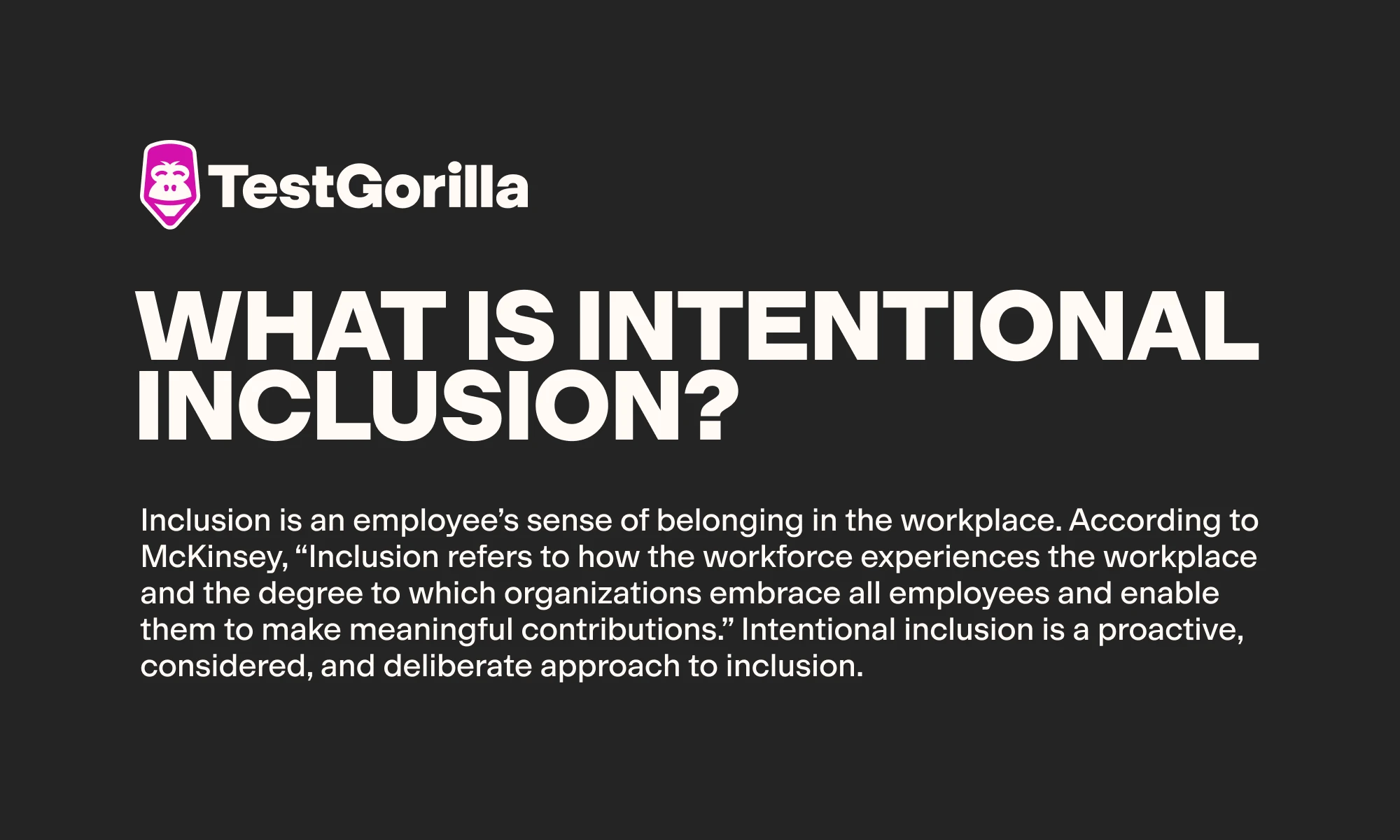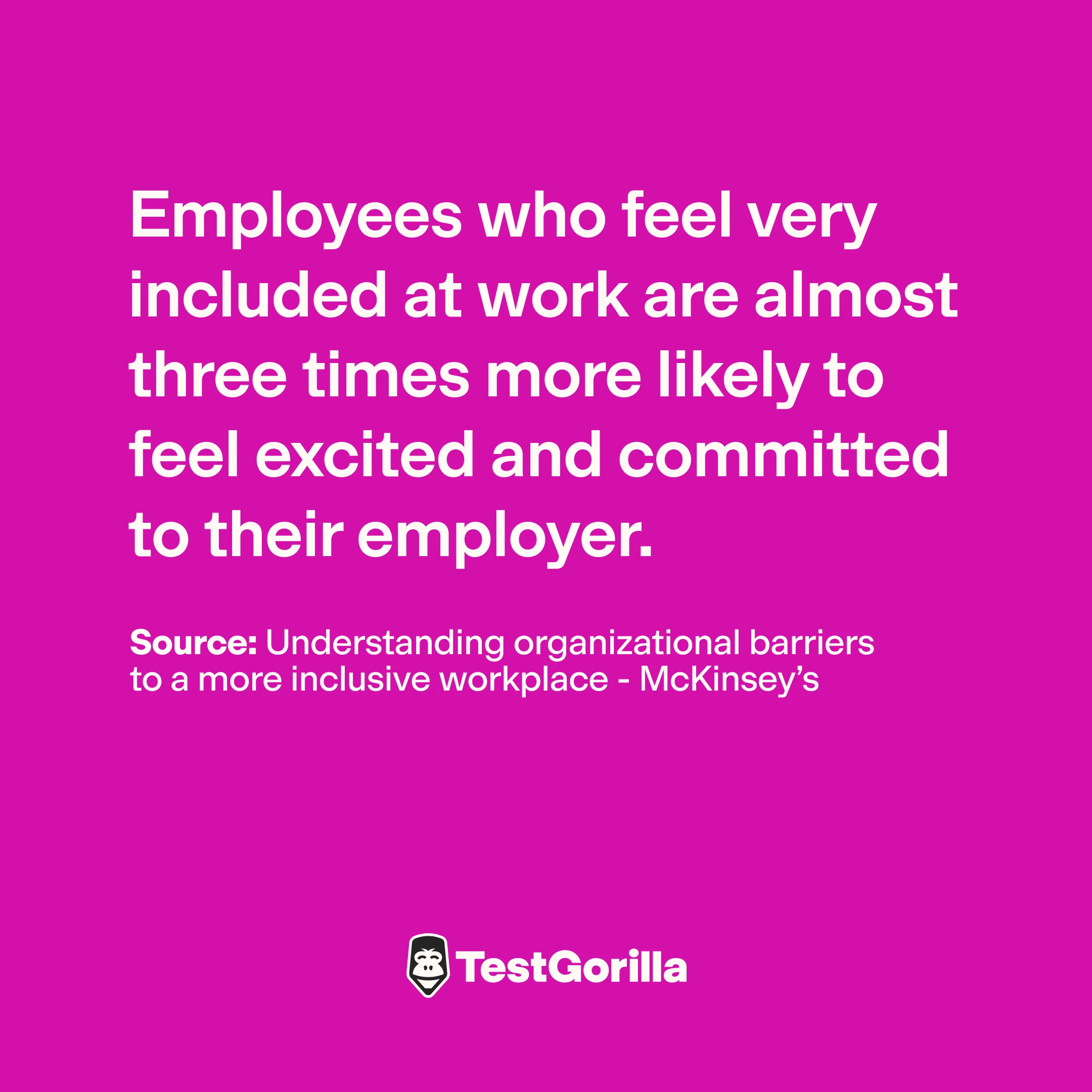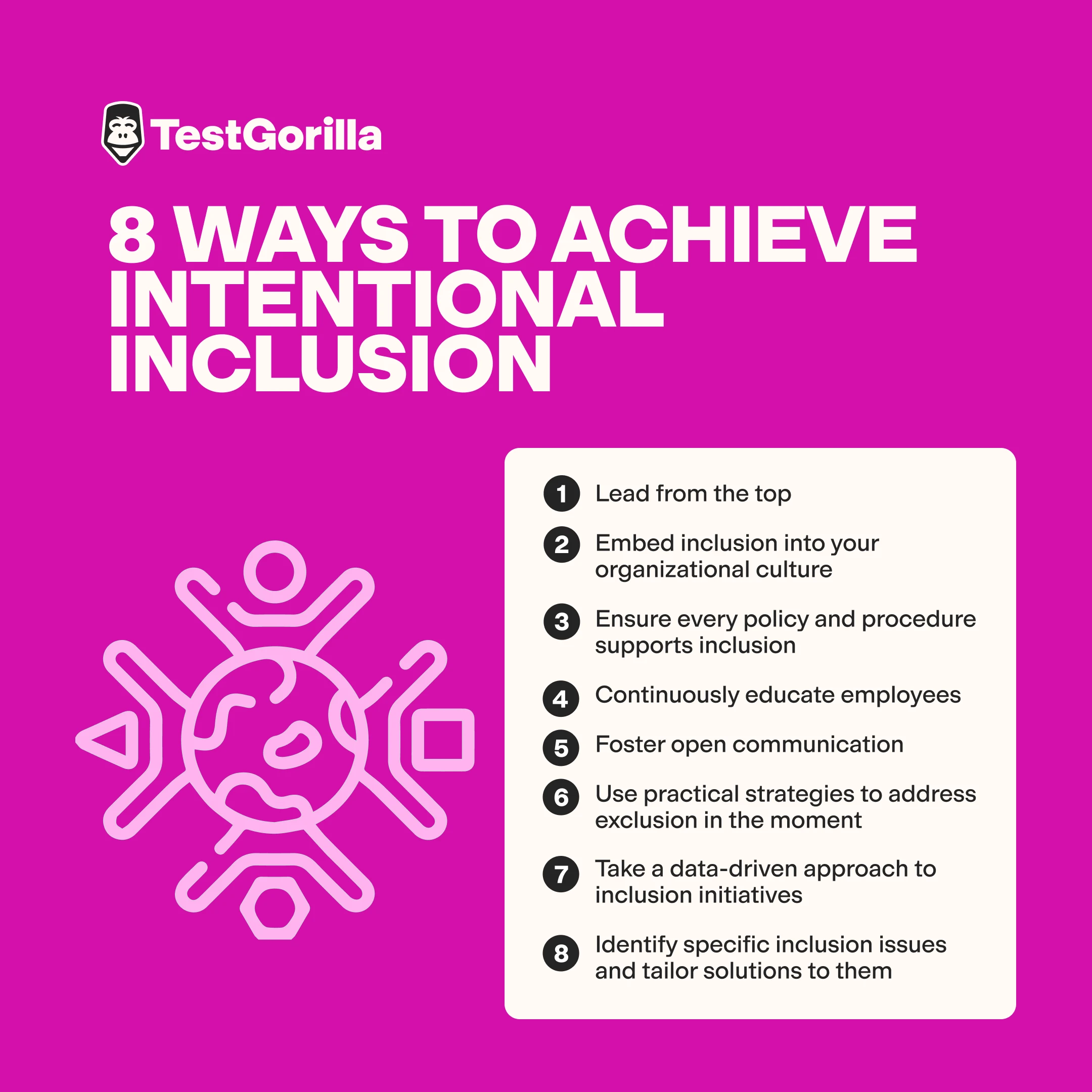Intentional inclusion: What it is and how to implement it at work
Several organizations have committed to diversity, equity, and inclusion (DEI). In fact, the DEI global market was $10.9 billion in 2023 and is projected to increase to $24.4 billion by 2030. [1]
However, a commitment to building a diverse workforce won’t lead to results without a considered approach.
The key to accessing the benefits of diversity? We believe it’s intentional inclusion.
Below, we dive into intentional inclusion – what it is, its benefits, and how to use this approach to ensure your broader DEI efforts are effective.
What is intentional inclusion?
To define “intentional inclusion,” we must first define “inclusion.”
Inclusion is an employee’s sense of belonging in the workplace. According to McKinsey, “Inclusion refers to how the workforce experiences the workplace and the degree to which organizations embrace all employees and enable them to make meaningful contributions.”
Inclusion is central to the concept of DEI. The importance and benefits of workplace diversity are widely understood. However, without genuine inclusion, these benefits can’t be realized. You could recruit the most diverse workforce – but if your employees don’t feel included, they’re unlikely to be engaged with their work or committed to your organization.
Some organizations merely pay lip service to inclusion – making grand commitments without backing them up with meaningful action that fosters genuine inclusion (much like diversity washing).
The solution? Intentional inclusion.
Intentional inclusion is a proactive, considered, and deliberate approach to inclusion. It involves:
Identifying signs or instances of exclusion in the workplace, like covering or microaggressions
Developing strategies to address exclusion and support inclusion
Measuring the outcomes of these strategies to ensure they’re effective
A burst of corporate DEI activity followed the murder of George Floyd in 2020 and the Black Lives Matter movement, including impassioned public commitments to improving DEI in the workplace. However, since then, there’s been an ever-increasing gap between the DEI commitments of organizations and outcomes. We’re now also seeing the rollback of many corporate DEI initiatives.
Intentional inclusion is one key to closing this gap – turning DEI promises into effective strategies and real action.
The arguments for intentional inclusion
There’s a strong business case for taking a considered, strategic approach to inclusion.
1. Attracts top talent
Candidates are increasingly demanding genuine inclusivity from potential employers.
According to a McKinsey global survey on inclusion that involved 1,920 participants, 39% of respondents said they’d turned down jobs because of a perceived lack of inclusion on the part of the employers, with racial- or ethnic-minority and LGBTQ+ candidates being most likely to do so.
These sentiments are especially strong for younger candidates. In a Monster survey of over 1,000 job seekers, 83% of Gen Z candidates cited an organization’s commitment to diversity and inclusion as an important factor when choosing an employer.
By using intentional inclusion, employers can attract more diverse, qualified talent. This was the experience of the Idaho National Laboratory, which saw 187% growth in qualified applicants after introducing intentional inclusion policies and practices.
2. Increases employment engagement
In an inclusive work environment, employees feel like they genuinely belong. They feel comfortable expressing their ideas and concerns, knowing their contributions are valued. The result? Higher satisfaction and engagement.
McKinsey’s inclusion survey found that employees who feel very included at work are almost three times more likely to feel excited and committed to their employer.
3. Reduces employee turnover
A sense of belonging is critical to providing employees a psychologically safe workplace. A LifeSpeak Inc. report – which involved a survey of 1,000 employees and 1,000 HR professionals – revealed that employees who feel like they don’t belong are 59% more likely to think about leaving due to mental health concerns.
4. Fosters better innovation
When employees feel safe sharing their ideas and concerns, organizations benefit from their diverse perspectives and experiences – which lead to more creative problem-solving. Inclusion also reduces the risk of groupthink, where everyone is influenced by others’ positions.
A study by the Josh Bersin Company involving over 450 companies worldwide found that more inclusive companies are 1.7 times more likely to be innovation leaders in their industry. These companies also saw 2.3 times higher cash flow per employee.
The best insights on HR and recruitment, delivered to your inbox.
Biweekly updates. No spam. Unsubscribe any time.
Potential challenges to intentional inclusion
A number of organizations are falling behind on inclusion. Here are some challenges they face in adopting an intentional approach to inclusion – plus solutions.
1. Failing to recognize a problem
Exclusion in the workplace can be subtle. Unconscious bias – internal prejudices someone has without realizing it – can make it difficult to assess the situation objectively. Organizations may not even be aware they need to address inclusion problems.
🛠️ The solution: Kick off your efforts with this article and look for instances of subtle exclusion in your workplace.
2. A lack of resources
Some businesses, especially smaller ones, may worry about the cost of ambitious inclusion strategies. Some DEI measures can require a significant investment – but there are plenty of ways to practice intentional inclusion without a hefty price tag.
🛠️ The solution: Realize the opportunity cost of not adopting an intentional approach to inclusion: Your organization misses out on many of the benefits discussed above and the potential savings they offer.
3. A lack of DEI expertise
Organizations that lack DEI expertise may feel unequipped to adopt intentional inclusion. Drawing on survey data from over 175,000 employees, CultureAmp’s 2024 Workplace Diversity, Equity, and Inclusion report found that a lack of expertise was the number one challenge facing DEI teams in 2023.
🛠️ The solution: Take advantage of available DEI resources, including on SHRM’s and McKinsey’s websites. Realize you don’t need a PhD in DEI to be intentional about inclusion – you just need simple, practical approaches.
4. DEI backlash
The last few years have seen a political, legal, and cultural shift questioning DEI in the workplace. This is illustrated by the Society for Human Resource Management (SHRM) – the world’s largest HR organization – recently dropping the “E” from DEI.
With several US states passing laws banning the use of public funds for DEI programs, several conservative politicians have tried to rebrand DEI as “discrimination, exclusion, and indoctrination.”
These external pressures make some organizations feel reluctant to continue their existing DEI initiatives – let alone roll out more ambitious ones.
🛠️ The solution: Be bold. At TestGorilla, we firmly believe that genuine DEI requires organizations to push against these sentiments.
Strategies for achieving intentional inclusion
Here are eight ways to support intentional inclusion in your organization.
1. Lead from the top
For an organization to be genuinely inclusive, the message must come from leadership. Leaders set the tone for everyone else in the organization on creating an inclusive workplace. But how can they do this?
Making public commitments to intentional inclusion is a good start, but these must be backed up by real action, such as:
Addressing microaggressions they witness
Encouraging open and safe communication about identity in the workplace
Modeling fairness and equity in their decisions
Practicing active listening when employees share concerns or ideas about inclusion
Representation at higher levels also matters. Employees who can’t see themselves reflected in leadership are unlikely to feel fully included.
McKinsey’s inclusion survey supports this –
The presence of diverse leaders…and an organization’s focus on inclusive leadership (for example, leaders empowering others) are correlated with individuals feeling included.
In fact, the survey shows employees in organizations with these factors are 1.5 and 1.7 times more likely (respectively) to feel included.
2. Embed inclusion into your organizational culture
There are tons of ways to infuse inclusion into your culture.
According to McKinsey, centering your culture around merit is important for employees to feel included. Focusing on individuals’ abilities and performance to promote fairness and reduce the impact of biases on opportunities and rewards.
Emphasize that inclusion is the whole organization’s responsibility – not just the responsibility of minority groups. Guangyu Li, senior partner at McKinsey, says, “It shouldn’t be left to any individual community to defend itself. It’s in our collective interest to show up for each other with concrete action and to come together in solidarity.”
Formal sponsorship and mentorship programs are great for this. While mentorship focuses on guidance, support, and advice, sponsorship involves an employee in a leadership role actively advocating and creating opportunities for another employee. As Gallup explains, “a sponsor opens the door to opportunities for another employee, while a mentor [helps them] open the door for themselves.”
Also, larger organizations should consider appointing someone to oversee DEI. This person can assess the state of inclusion within the organization, develop inclusion strategies, manage their implementation, and track their success.
3. Ensure every policy and procedure supports inclusion
Review your existing policies and practices to ensure they are genuinely inclusive. For example, does your dress code unintentionally restrict employees from wearing religious headdresses?
Be sure to look closely – some policies appear non-discriminatory and inclusive at first glance but have a disparate negative impact on a specific group of employees.
For example, you may have a policy against flexible work. This policy seems fair. It applies to all employees equally, and the work hours aren’t an issue for most employees. However, this policy may greatly impact workers who are caregivers and require flexibility to pick up their children from daycare or school. It may also impact Muslim employees who prefer to work earlier when fasting during Ramadan.
Remember when reviewing your policies and practices that intentional inclusion should inform every stage of the employee lifecycle, including hiring. For instance, skills-based hiring practices are great for supporting genuine inclusion. By focusing on skills and abilities rather than qualifications or job experiences – which are potentially influenced by privileges or disadvantages – you won’t exclude candidates with the skills and potential to excel in your role.
Thomas Coffin, VP of Engineering at TestGorilla, describes his first-hand experience with adapting practices to be more inclusive:
In my previous position, when looking for a new engineering manager, there was a subconscious tendency to choose the most technical, expert person in the team, usually a man. I made an effort to dig into the skills and potential of all women in my team to ensure we weren't missing great talent. It wasn't about just replacing a man with a woman but about recognizing unconscious biases and realizing that leveling the field required leadership to spend more time considering less obvious choices.
4. Continuously educate employees
As Li highlights, inclusion is a collective effort. That’s why delivering regular DEI training to your employees is essential to intentional inclusion.
Your training should cover inclusion, as well as related topics, like:
Unconscious bias
Inclusive communication
Microaggressions (in McKinsey’s inclusion survey, a startling 84% of respondents reported experiencing microaggressions in the workplace)
Intersectionality, which is when several types of discrimination overlap as a result of an individual belonging to several groups (for example, a woman with a disability experiences layers of discrimination)
Empathy and active listening skills
Allyship – supporting and advocating for marginalized groups you’re not a member of – is a key topic to include in your inclusion training. Thomas Coffin says:
Allyship and inclusive behaviors have a virtuous cycle. The more you care, the more you educate yourself. The more you demonstrate it publicly, the more others will trust you, and the more they will share with you about existing non-inclusive behaviors. The more you will learn, leading you to care even more.
Including this training in your onboarding materials sets the tone from day one with new employees. Ensure you also provide regular training to your workforce, either in person or online.
Above all, make training engaging and actionable. For instance, don’t just give employees written materials explaining what microaggressions are. Role-playing exercises involving aggressors, victims, and bystanders will be more engaging and memorable. Give employees tools for handling microaggressions as victims and bystanders in these exercises – for instance, strategies from this micro-interventions toolkit.
5. Foster open communication
Open communication is key to identifying instances of inclusion in your workplace and supporting employees’ sense of belonging.
Setting up employee resource groups (ERGs) or groups of workers with shared experiences is one way to build workplace inclusivity. These groups give individuals a safe space to raise any concerns about inclusion in the organization. It also offers employees a formal way to provide feedback to management on issues of exclusion.
We spoke to KIS Finance HR consultant Susan Andrews, who says ERGs “help people connect, making inclusion part of the company’s DNA and reinforcing the message that everyone’s voice matters.”
Recognizing that inclusion and identity can be a sensitive issue for some, you can also run anonymous employee pulse surveys to get a picture of inclusion in your organization. Some employees may feel more comfortable sharing their feedback anonymously.
6. Use practical strategies to address exclusion in the moment
While intentional inclusion can involve strategic, longer-term measures, managers can also take many practical steps to address instances of exclusion immediately.
Here are some examples.
Exclusion example | Solution |
An employee constantly interrupts employees during meetings | Politely say, “Let’s allow [name] to finish what they were saying.” |
Members of a team report repeated or serious instances of exclusion by their supervisor | - Arrange a meeting with the employee in question to constructively discuss the issue. - Provide them with additional intentional inclusion training. |
An employee often takes credit for other employee’s ideas | Credit the original employee by saying, “Yes, that was originally [name’s] idea. Good thinking, [name].” |
A group of employees regularly exclude one employee (you learn this second-hand) | - Meet with the employee and encourage them to share their experiences if they wish to. - Consider disciplinary action, mediation, or other appropriate solutions based on what you learn. |
A new employee isn’t invited to an important meeting | Acknowledge the mistake and invite them to the meeting by explaining you value their contributions. |
An employee regularly mispronounces a colleague’s name | - Approach the employee in private to gently explain the importance of pronouncing names correctly and encourage them to do so. - Pronounce employee’s names correctly to model this behavior. |
7. Take a data-driven approach to inclusion initiatives
Once you’ve chosen and implemented the tactics you want to support inclusion, measuring outcomes is essential. This helps you see what’s effective – so you can replicate it – and what isn’t – so you can adjust.
Managing director and global chief DEI officer at Ares Management, an international asset management firm, Indhira Arrington, explains her approach: “We’re setting KPIs, and we’re holding ourselves accountable for the change we want to see – because we believe that what gets measured gets done.”
Tracking outcomes helps you get the best ROI from your inclusion strategies. It’s also a gesture of transparency, showing that the organization is ready to be held accountable for its intentional inclusion promises.
Measuring outcomes starts early. Assess inclusion within your organization now by measuring diversity and inclusion metrics, such as retention, employee experience, and diversity in leadership. You can also gather helpful qualitative data by speaking to employees at all levels of the organization.
This information can help you identify any issues with or opportunities for inclusion, choose strategies to address them, and pinpoint outcomes you want to achieve.
After introducing your inclusion strategies, continue to measure diversity and inclusion metrics, compare them with past metrics, and check in with your employees regularly to track your strategies’ effectiveness.
8. Identify specific inclusion issues and tailor solutions to them
The above strategies are ones every organization can use. However, intentional inclusion also requires tailored solutions to address the problems unique to your business.
EY’s Neuro-Diverse Centers of Excellence (NCoEs) are an excellent example of a tailor-made intentional inclusion strategy. EY recognized the difficulty neuro-divergent individuals faced entering the workforce despite often having the high-level technical and industry-specific skills the organization was seeking.
To address this, the organization developed the NCoE program to recruit, train, and support neuro-diverse professionals. EY now has 23 NCoEs worldwide and reports a 92% retention rate for employees hired through these centers.
Karyn Twaronite, global vice chair of DEI, explains that EY had to tailor its NCoE program further once it realized another inclusion issue – it was failing to attract female applicants. EY addressed this by removing barriers in their hiring materials, including non-inclusive language.
Speaking to the BBC, Twaronite says, “Every class that we hired after that has had gender parity, but it did require much more intentionality on our part to speak specifically to this population… We had to be proactive.”
You can’t have genuine DEI without intentional inclusion
Intentional inclusion requires you to be proactive, considered, and deliberate in ensuring employees feel like they belong. This involves leading by example, embedding merit into your culture, using skills-based hiring to level the playing field, and providing employees with ongoing DEI training.
Inclusion is much more than a buzzword – it’s a powerful tool that requires a strategic, considered approach. Are you ready to step up?
Sources:
[1] Diversity and Inclusion (D&I) - Global Strategic Business Report. (2024).
https://www.researchandmarkets.com/reports/5519706/diversity-and-inclusion-dandi-global-strategic
You've scrolled this far
Why not try TestGorilla for free, and see what happens when you put skills first.






















